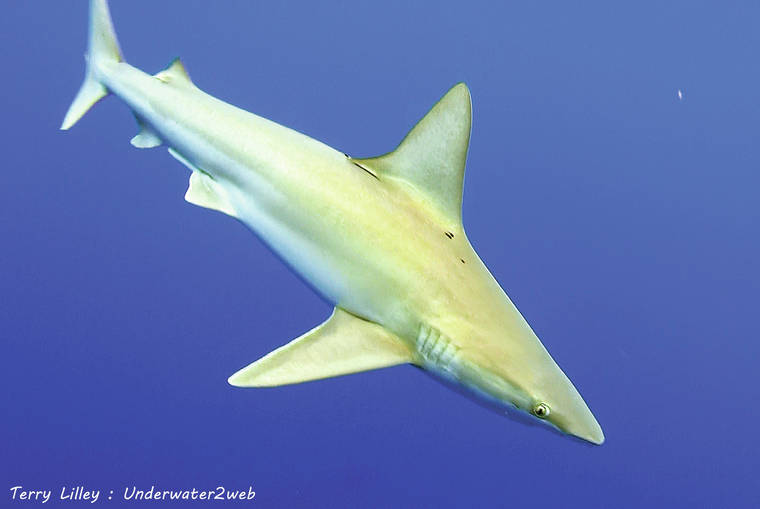I have scuba dove with all of the known shark species here in the Hawaiian Islands, and I find the sandbar shark the most mysterious. I went out on a boat out of Hale‘iwa, O‘ahu with shark expert Ocean Ramsey four miles straight out to sea on a clear sunny day. We passed a pod of dolphins along the way but other than that we stopped in the middle of nowhere in clear, blue water with the sea floor over 400 feet deep below us.
This was not the part of the sea that I would expect to see any sharks at all. We jumped in the warm water with our camera gear and within 60 seconds we started seeing shadows coming up from the deep blue. At first we were just circled by a dozen or so circling dark-gray shadows. It was like being in deep space and seeing dark planets orbiting around you. Then out of nowhere an eight-foot-long, 300-pound shark materialized and came right at us. It looked like an Air Force fighter jet coming in for the kill with its huge fins mounted way up close to its head. The shark zoomed by us so close I could see it’s small eye looking up and down from my head to my fins
Within 10 minutes we had a dozen very-large sharks circling us as we repeatedly dove down to 60 to 80 feet into the deep blue and shot video of these solid-silver gray sharks as they circled us about 20 feet away. What a thrill. No one made any aggressive maneuvers and they just seemed to want to check us out to see what we were doing way out in the middle of the sea. Underwater, the sandbar shark is the most impressive shark I have ever seen, with its huge pectoral fins that look like the wings on a jet plane, and their large, strong tail that can send them in any direction fast.
Sandbar sharks normally live in deep water off the Hawaiian coastline and are rarely seen by divers except on the islands of Lehua and Ni‘ihau off the coast of Kaua‘i, where they come out of the deep to visit the frequent scuba divers. These sharks are very fast, and they feed on sick or dying fish, crabs and lobsters. They are hyper-sensitive to humans in the water, and they can pick up our swimming movements from hundreds of feet away so they know we are there before we know they are there.
They also have electromagnetic sensors that can monitor our body vibrations, and they have super- good vision and smell.
Sandbar sharks have never been known to bite humans, but once a year they come up into shallow water to have their babies. I was diving at Ni‘ihau when two pregnant female sandbar sharks came up from the deep and then they charged me. I have dove with tiger sharks, great white sharks, bull sharks and many other shark species, and I have never been charged. One large female sandbar came right at me super fast, so I put my camera up between the two of us and she turned away at the last second. I got an amazing video clip. She charged twice then relaxed, and I dove with the two of them for an hour. I just think she was wanting to know if I was a predator or not as she was very close to giving birth and needed to protect her offspring.
You can see the sandbar sharks in action in “The World’s Guide To Hawaiian Reef Fish” at www.underwater2web.com. We should also have the movie posted online soon on our nonprofit web.
Terry Lilley is a marine biologist living in Hanalei Kauai and is a co-founder of Reef Guardians Hawaii, a nonprofit on a mission to provide education and resources to protect the coral reef. To donate to Reef Guardians Hawaii, go to www.reefguardianshawaii.org
•••
Terry Lilley is a marine biologist living in Hanalei and is a co-founder of Reef Guardians Hawaii, a nonprofit on a mission to provide education and resources to protect the coral reef. To donate to Reef Guardians Hawaii, go toreefguardianshawaii.org. His websites include underwater-2web.com and gofundme.com/5urrm4zw.



